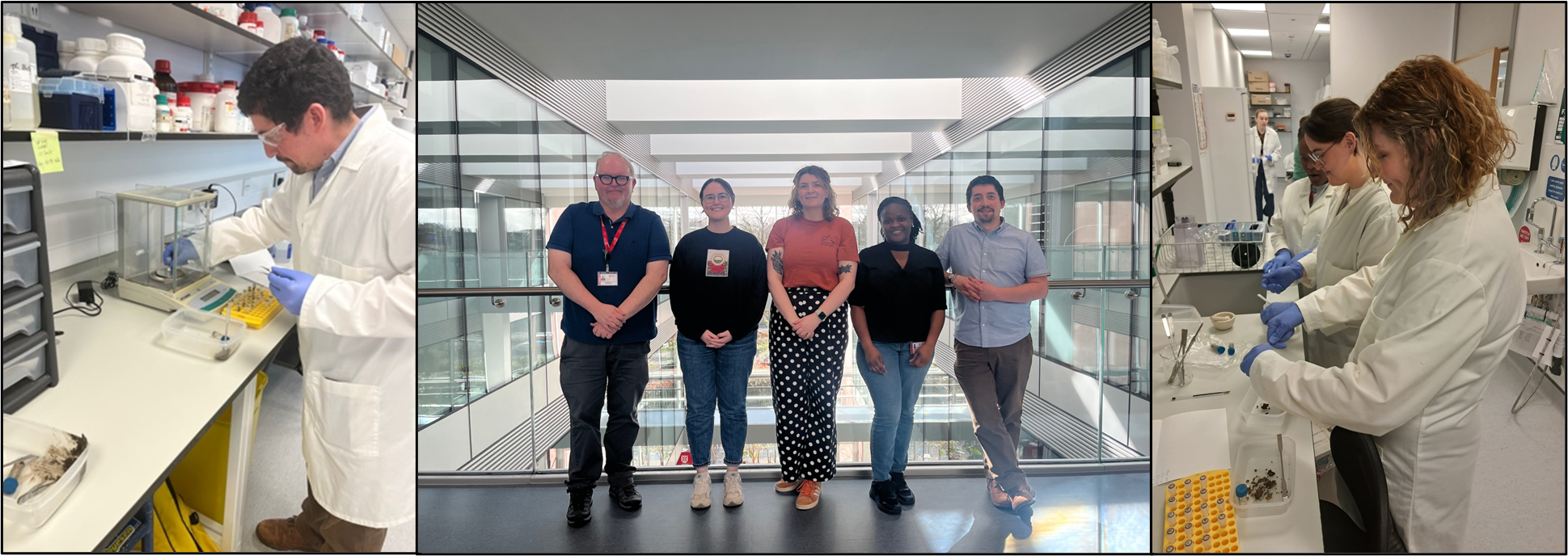
The HUGS conducts extensive zoonotic surveillance of helminths, primarily in livestock, but also extending to non-human primates. Dr Alexandra Juhasz will soon publish her work providing novel insights into Strongyloides infections affecting vervet monkeys in Malawi. This was made possible by a close partnership with Knowsley Safari and their baboon troop. Much of this research is conducted by analysing faecal samples, isolating larval forms of the parasites and employing molecular and microscopy identification techniques. However, this raised an important question: could environmental sampling also be an effective method for monitoring parasitic infections?
Last week saw the visit of Dr Lucas Cunningham and PhD student Ruth Cowlishaw to Prof Geoffrey Gobert's lab at Queen's University Belfast. The visit aimed to gain important insights into environmental sampling under the expert eye of PhD student Emer Mcann. Emer employs environmental DNA (eDNA) samples from soil, grass, and water to monitor gastrointestinal parasites of sheep across Northern Ireland, providing her with invaluable knowledge and experience she could share with us. Ruth will also incorporate eDNA sampling into her work, investigating the transmission dynamics of Strongyloides fuelleborni and Trichuris trichiura in non-human primates. Receiving early insights and expert guidance was crucial to maximising project potential.
The visit began with a tour of the laboratories at QUB, followed by a knowledge exchange session to highlight current projects and research interests. Hearing about Emer's and Daisy's (Namirembe) work was fascinating, discovering research overlaps and sharing ideas.
Day two saw the implementation of soil DNA extraction methods, gaining invaluable tips and tricks along the way. The LSTM contingent had brought over soil samples from a known Strongyloides transmission site in the UK. It was keen to discover if the parasite could be identified through environmental DNA in the soil. Strongyloides had previously been identified from the same area using the Baermann method to isolate larvae from soil and carry out DNA extraction on the larval pellet. However, parasite identification directly from the soil streamlines the process, saving time and resources. After a long day of pipetting and successful extractions, we all continued discussions over some of Belfast's culinary delights.
Our final day allowed us to run RT-PCR on our newly extracted soil samples. Although beneficial to us, this process also proved insightful for Emer and Daisy, who had not yet applied this technique to their projects. Dr Cunningham shared his expertise from the HUGS project with Daisy, who is commencing her investigations into potential Schistosoma hybridisation in Ugandan cattle. Despite the apparent absence of Strongyloides within the soil samples on this occasion, which is not surprising given the very low infection rate, our visit to QUB gave us lots to think about and learn from.
We are very grateful to our hosts for taking time out of their busy schedules to share knowledge and guide us. Knowledge exchange is key to curating effective working relationships and pushing forward progress. We hope to welcome our friends at QUB to LSTM soon.